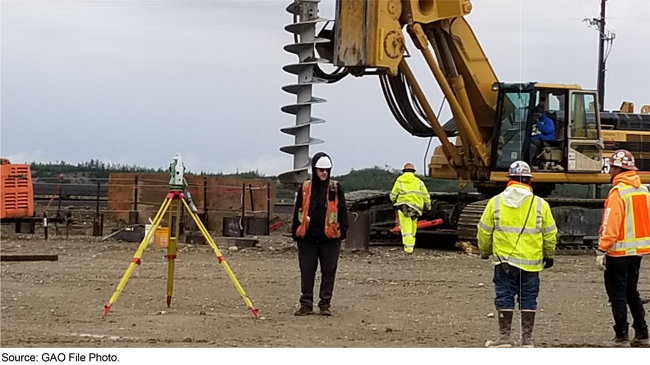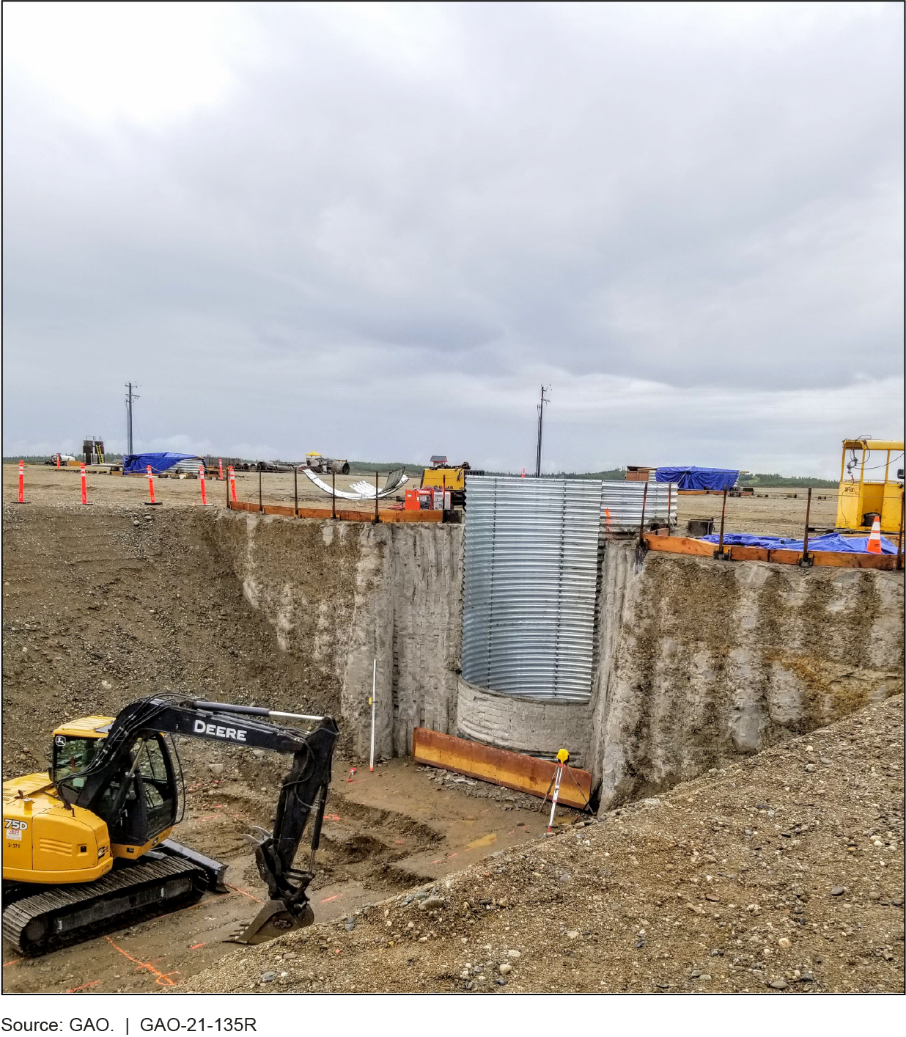Missile Defense: Observations on Ground-based Midcourse Defense Acquisition Challenges and Potential Contract Strategy Changes
Fast Facts
The Ground-Based Midcourse Defense system aims to defend the U.S. against ballistic missile attacks from rogue states like North Korea.
Since the 1990s, the Department of Defense has largely relied on a prime contractor to manage development of this complex system. It is considering a new approach where multiple prime contractors would develop system components, and DOD, potentially, would integrate them into the larger system. This approach offers potential benefits, such as greater insight into cost, schedule, and performance. However, challenges—such as hiring staff with enough expertise and access to technical data—could outweigh benefits.
Ongoing Construction of a New Ground-based Midcourse Defense Interceptor Field

Highlights
What GAO Found
The Missile Defense Agency (MDA) is developing a system to defend the U.S. from long-range missile attacks. As MDA continues to develop this system, called Ground-based Midcourse Defense (GMD), it has opportunities to incorporate into its approach lessons learned from over 2 decades of system development. MDA has made progress in developing and fielding elements of the GMD system. For example, MDA is constructing a new missile field to expand the fleet of interceptors. However, MDA has also experienced significant setbacks. Most recently, the Department of Defense canceled development of a key GMD element, the Redesigned Kill Vehicle, in 2019 because of fundamental problems with the system's design.
Ongoing Construction of a New Ground-based Midcourse Defense Interceptor Field (July 16, 2019)

Over the years, GAO has identified practices that MDA could apply to the GMD program to improve acquisition outcomes, such as:
- Using knowledge-based acquisition practices
- Involving stakeholders early and often
- Providing effective oversight
- Promoting competition
- Performing robust testing
GAO has also made numerous recommendations to improve MDA's acquisition outcomes and reduce risk. As of July 2020, the department has concurred with most of the recommendations GAO made since MDA's inception in 2002. Although the department has implemented many of the recommendations, it has further opportunities to implement the remaining open recommendations and apply lessons learned on a major, new effort to develop a next-generation GMD interceptor.
Since the late 1990s, DOD has executed the GMD program through a prime contractor responsible for developing and integrating the entire weapon system. MDA is considering taking over these responsibilities for GMD for the next phase of the program. GAO found that this approach offers potential benefits to the agency, such as more direct control over and greater insight into GMD's cost, schedule, and performance. However, the approach has some challenges that, if not addressed, could outweigh the benefits. For example, MDA may encounter challenges obtaining the technical data and staffing levels necessary to manage this complex weapon system, which could ultimately affect its availability or readiness. As of October 2020, MDA has not yet determined an acquisition strategy for the next phase of the GMD program.
Why GAO Did This Study
The GMD system aims to defend the U.S. against ballistic missile attacks from rogue states like North Korea or Iran. DOD has been developing this system since the 1990s and has spent $53 billion on the system so far. GMD is a complex system that includes interceptors and a ground system, and MDA has largely relied on a contractor, Boeing, to manage development and system integration. MDA is considering moving away from this approach as the program embarks on developing a key element of the GMD, a new interceptor.
The House Armed Services Committee included a provision in a report for GAO to assess the GMD contract structure and identify potential opportunities to improve government management and contractor accountability. This report addresses (1) the lessons learned from challenges MDA encountered acquiring the GMD system and (2) the potential benefits and risks of MDA taking over system integration responsibilities for GMD.
To conduct this work, GAO reviewed GMD program documentation, prior GAO reports on missile defense, GAO interviews with other DOD components, and expert panel reviews of GMD. GAO also spoke with officials from MDA and other DOD components.
Recommendations
GAO has 17 open recommendations aimed at improving missile defense acquisition outcomes and reducing risk. Recently, DOD has taken steps to address some of these open recommendations, but further action is needed to fully implement the remaining recommendations.
